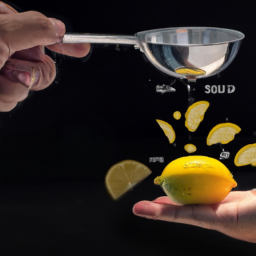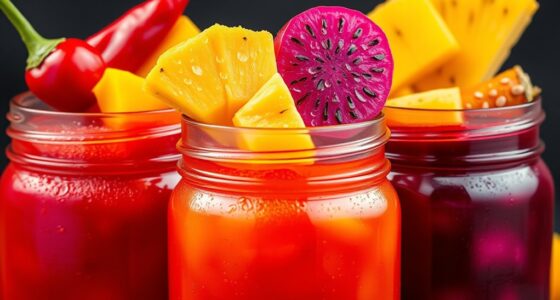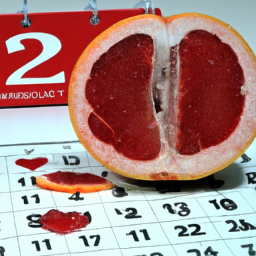As a cooking enthusiast who loves experimenting with new flavors, I frequently find myself wondering, “How much juice can you get from one lime?” This question is not as straightforward as it seems, due to the significant differences in lime size and ripeness, as well as the varying amounts of juice needed in different recipes.
But fear not, because I’ve done the research and experimentation so you don’t have to. In this article, I’ll break down everything you need to know about getting the most juice out of your limes, including the standard measurement, techniques for juicing, and tips for maximizing your yield.
First things first, let’s talk about lime size and ripeness. When it comes to juicing limes, you want to look for fruits that are plump, firm, and heavy for their size. Avoid limes that are overly soft or have brown spots, as these are signs of over-ripeness or decay. Keep in mind that limes can vary in size from small key limes to larger Persian limes, so adjust your measurements accordingly.
As a general rule of thumb, one lime will yield about 1-2 tablespoons of juice, but this can vary based on size and ripeness.
Now, let’s get into the nitty-gritty of juicing those limes.
Key Takeaways
- One lime yields 1-2 tablespoons of juice; ripe limes yield more juice
- Lime juice measurement: standard measurement is 1 tablespoon; 1 oz in cocktails
- Microwaving limes for 10-15 seconds before squeezing can soften fruit and increase juice yield
- Lime juice substitutes: lemon juice or vinegar/citric acid-based substitutes can be used.
Understanding Lime Size and Ripeness
You’ll want to choose limes that are bright green and feel heavy for their size to ensure the juiciest squeeze possible. Lime varieties come in different sizes, but the standard Persian lime is the most commonly used in recipes. However, you may also come across the smaller key lime or the larger Bearss lime.
It’s important to select limes that are ripe but not overripe. Overripe limes will be yellow and soft, and they won’t produce as much juice as green, firm limes. If you’re unable to find fresh limes, lime juice alternatives such as bottled lime juice or frozen lime juice concentrate can be used as a substitute, but fresh lime juice will always provide the best flavor.
When it comes to measuring lime juice, the standard lime juice measurement is typically 1 tablespoon. However, this can vary depending on the size and juiciness of the lime. Some limes may yield more than 1 tablespoon of juice, while others may yield less. It’s important to keep this in mind when following recipes that call for lime juice. You may need to adjust the amount of lime juice you use to achieve the desired flavor.
The Standard Lime Juice Measurement
When making cocktails, it’s important to know that the standard measurement for lime juice is about one ounce. This measurement is based on the typical size and juiciness of a lime. However, it’s important to note that lime juice alternatives, such as bottled lime juice or a combination of lemon and lime juice, can also be used in cocktails.
To better understand the standard measurement of lime juice, here’s a table comparing the average amount of juice per lime to the standard measurement of one ounce:
| Lime Size | Juice per Lime | Standard Measurement |
|---|---|---|
| Small | 1/2 ounce | 2 limes |
| Medium | 3/4 ounce | 1 1/3 limes |
| Large | 1 ounce | 1 lime |
Using a citrus juicer can make it easier to extract the maximum amount of juice from a lime.
Using a Citrus Juicer
To get the most out of your cocktail’s citrus flavor, try using a citrus juicer – it’ll make all the difference in the world! Citrus juicers come in different types and sizes, but they all work by extracting the juice from the fruit without the bitter pith.
Here are some advantages of using a citrus juicer:
-
Consistent results every time: A citrus juicer ensures that you get the same amount of juice from each lime, allowing you to measure the exact amount of lime juice needed for your recipe.
-
Time-saving: Using a citrus juicer is a quick and efficient way to extract the juice from your limes, especially when compared to hand-squeezing each lime.
-
Less mess: A citrus juicer catches the juice in a container, eliminating the need for a separate bowl to catch the juice and reducing the mess on your countertops.
-
Citrus juicer alternatives: If you don’t have a citrus juicer, you can use a hand-held juicer or an electric juicer as an alternative.
Choosing the right lime for juicing is also important. Ripe limes that are firm and heavy will yield more juice than unripe or overripe limes.
With a citrus juicer and the right limes, you’ll have perfectly extracted lime juice for your cocktails.
Moving forward, let’s talk about hand-squeezing limes and how to get the most juice out of them.
Hand-Squeezing Limes
When it comes to hand-squeezing limes, there are a few things I like to keep in mind. First and foremost, preparing the lime properly is crucial. I like to roll it on the counter with a little bit of pressure to help break down the fibers inside.
Additionally, there are different techniques for hand-squeezing that can help maximize the amount of juice extracted. By using a combination of these techniques and proper preparation, you can ensure you’re getting the most out of your limes.
Preparing Limes for Squeezing
First things first, before you start squeezing, cut your limes in half crosswise. This will make it much easier to extract the juice. When selecting your limes, keep in mind that different lime varieties may require different amounts of pressure to extract the juice. Key limes, for example, are smaller and more delicate than regular limes and may require a gentler hand.
To prepare your limes for squeezing, follow these steps:
-
Roll the lime on a hard surface before cutting it in half to help loosen the juice.
-
Use a sharp knife to cut the lime in half crosswise.
-
If your lime is particularly tough, use a citrus reamer or juicer to help extract the juice.
-
Finally, use your hands or a juice strainer to remove any seeds or pulp from the juice.
Once your limes are properly prepared, you can move on to the next step: hand-squeezing.
Techniques for Hand-Squeezing
Get ready to perfect your hand-squeezing technique by following these simple steps. First, make sure your hands are strong enough to squeeze the juice out of the lime. If you have weak hands, you may want to consider using juicing accessories such as a citrus press or a reamer. These tools can help you get the most juice out of your limes without straining your hands.
Once you are ready to hand-squeeze, follow these steps: Cut the lime in half crosswise, not lengthwise. Hold one half of the lime in your non-dominant hand with the cut side facing down. Place your dominant hand over the lime and squeeze firmly, using your fingers and palm to apply pressure. Rotate the lime and squeeze again until you have extracted all the juice. Repeat with the other half of the lime. By using this technique, you can maximize your lime juice output and ensure that you get the most flavor out of each fruit.
To further maximize your lime juice yield, we will discuss the amount of lime juice per lime in the next section.
Maximizing Your Lime Juice Yield
To get the most juice out of your limes, you’ll want to roll them on a hard surface before cutting them open – this will help break down the membranes and release more juice. Additionally, you can try microwaving your limes for 10-15 seconds before squeezing them. This will help soften the fruit and allow for more juice to be extracted.
A general rule of thumb is that one lime will yield about 1-2 tablespoons of juice. However, it’s always best to measure the juice to ensure accuracy in your recipes. And if you find yourself without any limes, you can try using lemon juice or even a lime juice substitute made from vinegar or citric acid.
When it comes to storing lime juice, it’s important to keep it refrigerated in an airtight container to prevent oxidation and maintain its freshness.
Storing Lime Juice
Now that I’ve maximized my lime juice yield, I need to figure out how to store it properly.
One of the key questions on my mind is how long lime juice lasts.
I also want to explore tips for freezing and thawing lime juice, so I can make the most of my lime supply.
How Long Does Lime Juice Last?
Lime juice can be stored in the refrigerator for up to a week, but it’s best to use it within three to four days for optimal freshness. If you’re unsure whether your lime juice has gone bad, there are a few ways to tell. First, check for any changes in color or texture. If the juice has become cloudy or has small particles floating in it, it may have started to spoil. Additionally, if the juice smells sour or has an off-putting odor, it’s likely that it’s no longer good to use.
To extend the shelf life of your lime juice, there are a few things you can do. First, make sure to store it in an airtight container to prevent any bacteria from getting in. Additionally, adding a small amount of sugar or salt to the juice can help preserve it for a longer period of time. Finally, freezing the juice can also extend its shelf life, which we’ll discuss in the next section.
Tips for freezing and thawing lime juice are important for those who want to use lime juice beyond its typical shelf life.
Tips for Freezing and Thawing Lime Juice
Freezing lime juice can extend its shelf life significantly, with one interesting fact being that it can last up to 6 months in the freezer. Here are some tips for freezing and thawing lime juice:
-
Use an airtight container to store the lime juice in the freezer. This will prevent freezer burn and keep the juice fresh for longer.
-
Fill the container only three-quarters full to allow space for the juice to expand as it freezes.
-
Label the container with the date the juice was frozen so you can keep track of how long it has been in the freezer.
When it comes to thawing lime juice, there are a few methods you can use. The easiest way is to simply leave the container in the refrigerator overnight. Alternatively, you can place the container in a bowl of warm water to speed up the process. Avoid using a microwave to thaw the juice, as this can cause the juice to lose its flavor and nutritional value.
With these freezing and thawing techniques, you can have fresh lime juice on hand for up to 6 months!
Experimenting with lime juice can be a fun and tasty way to add some zing to your meals. But before you start mixing and matching, it’s important to know how much lime juice to use per lime.
Experimenting with Lime Juice
I’ve been experimenting with lime juice in my cooking lately and I’ve found some unique and creative recipes to try. Combining lime juice with other flavors has been a fun way to create new dishes and add some brightness to old favorites.
From lime-infused guacamole to lime-marinated shrimp skewers, the possibilities are endless.
Unique and Creative Recipes to Try
If you’re looking to spice up your meals, why not try out some unique and creative recipes that are sure to impress your taste buds? Lime juice can be used in a variety of ways to add a burst of flavor to your dishes. From sweet to savory, there are countless creative uses for lime juice that you may not have considered before.
One creative use for lime juice is in flavor pairings. Lime juice pairs well with a variety of flavors, including cilantro, garlic, and ginger. Try mixing lime juice with these ingredients to create a zesty marinade for chicken or shrimp.
You can also add lime juice to salsa or guacamole for a tangy twist. For a sweet treat, combine lime juice with honey or agave nectar to make a refreshing limeade or cocktail. The possibilities are endless! So, why not experiment with lime juice and see what delicious creations you can come up with?
When it comes to combining lime juice with other flavors, there are a few things to keep in mind. Certain flavors can overpower the taste of lime juice, so it’s important to find the right balance. For example, if you’re adding lime juice to a dish that already has a strong acidic component, such as tomatoes or vinegar, you may want to use less lime juice to avoid overwhelming the dish.
However, if you’re combining lime juice with milder ingredients like avocado or coconut, you can use a bit more lime juice to enhance the flavor. Keep experimenting and trying new combinations until you find the perfect balance of flavors.
Combining Lime Juice with Other Flavors
Mixing lime juice with other flavors is like creating a symphony of tastes that harmoniously blend together. The tangy and zesty flavor of lime complements sweet and savory dishes, enhancing their taste and aroma.
Here are three ways to incorporate lime juice in your dishes:
-
Balancing lime with sweet flavors: Lime juice adds a refreshing twist to sweet treats, such as key lime pie or lemon bars. Its acidity balances the sweetness of the dessert, creating a perfect harmony of flavors.
-
Incorporating lime juice in savory dishes: Lime juice also pairs well with savory dishes, such as tacos, ceviche, or grilled chicken. Its acidity cuts through the richness of the dish, adding a bright and fresh taste to it.
-
Creating lime-infused drinks: Lime juice is a staple ingredient in cocktails and mocktails, such as margaritas, mojitos, or lemonade. Its tangy flavor adds a citrusy kick to the drink, making it more refreshing and flavorful.
Incorporating lime juice in your dishes is a simple way to elevate their taste and add a healthy dose of vitamin C. Speaking of which, did you know that lime juice has many health benefits? Let’s explore them in the next section.
Health Benefits of Lime Juice
The health benefits of lime juice are numerous, including its ability to aid digestion, boost immunity, and promote healthy skin. Lime water, in particular, has been known to alleviate constipation and promote hydration. Incorporating lime juice into your diet can also help regulate blood sugar levels and reduce the risk of heart disease.
Additionally, lime juice contains antioxidants that can protect against cancer and other chronic diseases. It’s important to note that while lime juice offers many health benefits, consuming too much of it can lead to negative side effects such as tooth decay and heartburn. As with any food or beverage, moderation is key.
In the next section, we’ll discuss some important safety considerations when consuming lime juice.
Lime Juice Safety
It’s crucial to remember that moderation is key when incorporating lime juice into your diet, as the adage goes, ‘everything in moderation.’ While lime juice has many health benefits, consuming too much of it can have negative effects on your health. Overconsumption of lime juice can lead to an upset stomach, heartburn, and even acid reflux due to its high acidity levels. It’s important to monitor your intake and not consume more than what your body can handle.
In addition to monitoring your intake, it’s also important to consider lime juice preservation techniques. Lime juice can be preserved by adding preservatives such as sodium benzoate or potassium sorbate, but these can have negative effects on your health in the long run. Alternatively, you can preserve lime juice by freezing it or adding it to a dish that will be cooked. By using these preservation techniques, you can enjoy the benefits of lime juice without compromising your health.
Frequently Asked Questions
Can you substitute bottled lime juice for fresh lime juice?
I wouldn’t recommend substituting bottled lime juice for fresh in recipes that specifically call for it. Fresh lime juice offers a brighter, more complex flavor and contains more nutrients. The benefits of using fresh lime juice are clear in taste and health.
How long does freshly squeezed lime juice last in the refrigerator?
Freshly squeezed lime juice lasts up to a week in the refrigerator when stored in an airtight container. It’s important to store it properly to maintain its potential health benefits. Use glass containers and avoid exposure to air.
Does the lime juice taste differ between limes of different sizes and ripeness?
In my experience, the flavor of lime juice can vary depending on the ripeness and size of the lime used. Riper limes tend to produce sweeter juice, while smaller limes may have a higher acidity level.
Is there a difference in juice yield between using a manual juicer versus an electric one?
As I compared manual and electric juicers, I noticed a significant difference in juice yield. The acidity level variation and lime size impact were notable factors. To put it simply, the electric juicer produced more juice than the manual one.
Can lime juice be frozen for later use?
Yes, lime juice can be preserved by freezing it in an airtight container for up to 6 months. This is a convenient way to have lime juice on hand for making cocktails or cooking.
Conclusion
So, there you have it. The perfect amount of lime juice per lime is around 2 tablespoons. But keep in mind that the size and ripeness of the lime can affect the amount of juice you get. Using a citrus juicer or hand-squeezing can also impact the yield of your lime juice.
Did you know that one lime contains about 30% of your daily recommended intake of vitamin C? In addition to its refreshing taste, lime juice is also packed with nutrients and health benefits. It can aid digestion, boost immunity, and even promote weight loss.
So, next time you’re making a recipe that calls for lime juice, don’t be afraid to experiment with different amounts and techniques. Your taste buds (and your body) will thank you.
Hi, I’m Alexander. I’m a vegan of over 20 years, and I initially made the switch for health reasons. However, as time went on, I became more and more passionate about the ethical and environmental implications of leading a vegan lifestyle.
I am the author of The Graceful Kitchen, a vegan blog where I share recipes for delicious and nutritious vegan meals. As someone who is deeply committed to living a cruelty-free life, I am also a strong advocate for using whole foods as the foundation of a healthy diet – and believe that going vegan is one of the best ways to achieve this.










